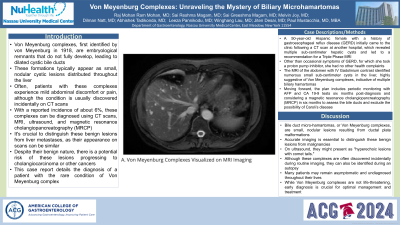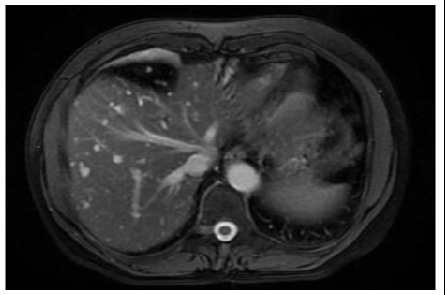Sunday Poster Session
Category: Liver
P1321 - Von Meyenburg Complexes: Unraveling the Mystery of Biliary Microhamartomas
Sunday, October 27, 2024
3:30 PM - 7:00 PM ET
Location: Exhibit Hall E

- RR
Rajmohan Rammohan, MD
Nassau University Medical Center
East Meadow, NY
Presenting Author(s)
Raj Mohan Ram Mohan, MD, Sai Reshma Magam, MD, Sai Greeshma Magam, MD, Melvin Joy, MD, Dilman Natt, MD, Abhishek Tadikonda, MD, Leeza Pannikodu, MD, Winghang Lau, MD, Jiten Desai, MD, Paul Mustacchia, MD, MBA
Nassau University Medical Center, East Meadow, NY
Introduction: Von Meyenburg complexes, first identified by von Meyenburg in 1918, are embryological remnants that do not fully develop, leading to dilated cystic bile ducts. These formations typically appear as small, nodular cystic lesions distributed throughout the liver. Often, patients with these complexes experience mild abdominal discomfort or pain, although the condition is usually discovered incidentally on CT scans. With a reported incidence of about 6%, these complexes can be diagnosed using CT scans, MRI, ultrasound, and magnetic resonance cholangiopancreatography (MRCP). It's crucial to distinguish these benign lesions from liver metastases, as their appearance on scans can be similar. Despite their benign nature, there is a potential risk of these lesions progressing to cholangiocarcinoma or other cancers. This case report details the diagnosis of a patient with the rare condition of Von Meyenburg complex.
Case Description/Methods: A 50-year-old Hispanic female with a history of gastroesophageal reflux disease (GERD) initially came to the clinic following a CT scan at another hospital, which revealed multiple subcentimeter hepatic cysts and led to a recommendation for a Triple Phase MRI. Other than occasional symptoms of GERD, for which she took a proton pump inhibitor, she had no other health complaints. The MRI of the abdomen with IV Gadolinium contrast identified numerous small subcentimeter cysts in the liver, highly suggestive of Von Meyenburg complexes, indicative of multiple biliary hamartomas. Moving forward, the plan includes periodic monitoring with AFP and CA 19-9 tests six months post-diagnosis and considering a magnetic resonance cholangiopancreatography (MRCP) in six months to assess the bile ducts and exclude the possibility of Caroli’s disease.
Discussion: Bile duct microhamartomas, or Von Meyenburg complexes, are small, nodular lesions resulting from ductal plate malformations. Accurate imaging is essential to distinguish these benign lesions from malignancies. On ultrasound, they might present as "hyperechoic lesions with comet tails." Although these complexes are often discovered incidentally during routine imaging, they can also be identified during an autopsy. Many patients may remain asymptomatic and undiagnosed throughout their lives. While Von Meyenburg complexes are not life-threatening, early diagnosis is crucial for optimal management and treatment.

Disclosures:
Raj Mohan Ram Mohan, MD, Sai Reshma Magam, MD, Sai Greeshma Magam, MD, Melvin Joy, MD, Dilman Natt, MD, Abhishek Tadikonda, MD, Leeza Pannikodu, MD, Winghang Lau, MD, Jiten Desai, MD, Paul Mustacchia, MD, MBA. P1321 - Von Meyenburg Complexes: Unraveling the Mystery of Biliary Microhamartomas, ACG 2024 Annual Scientific Meeting Abstracts. Philadelphia, PA: American College of Gastroenterology.
Nassau University Medical Center, East Meadow, NY
Introduction: Von Meyenburg complexes, first identified by von Meyenburg in 1918, are embryological remnants that do not fully develop, leading to dilated cystic bile ducts. These formations typically appear as small, nodular cystic lesions distributed throughout the liver. Often, patients with these complexes experience mild abdominal discomfort or pain, although the condition is usually discovered incidentally on CT scans. With a reported incidence of about 6%, these complexes can be diagnosed using CT scans, MRI, ultrasound, and magnetic resonance cholangiopancreatography (MRCP). It's crucial to distinguish these benign lesions from liver metastases, as their appearance on scans can be similar. Despite their benign nature, there is a potential risk of these lesions progressing to cholangiocarcinoma or other cancers. This case report details the diagnosis of a patient with the rare condition of Von Meyenburg complex.
Case Description/Methods: A 50-year-old Hispanic female with a history of gastroesophageal reflux disease (GERD) initially came to the clinic following a CT scan at another hospital, which revealed multiple subcentimeter hepatic cysts and led to a recommendation for a Triple Phase MRI. Other than occasional symptoms of GERD, for which she took a proton pump inhibitor, she had no other health complaints. The MRI of the abdomen with IV Gadolinium contrast identified numerous small subcentimeter cysts in the liver, highly suggestive of Von Meyenburg complexes, indicative of multiple biliary hamartomas. Moving forward, the plan includes periodic monitoring with AFP and CA 19-9 tests six months post-diagnosis and considering a magnetic resonance cholangiopancreatography (MRCP) in six months to assess the bile ducts and exclude the possibility of Caroli’s disease.
Discussion: Bile duct microhamartomas, or Von Meyenburg complexes, are small, nodular lesions resulting from ductal plate malformations. Accurate imaging is essential to distinguish these benign lesions from malignancies. On ultrasound, they might present as "hyperechoic lesions with comet tails." Although these complexes are often discovered incidentally during routine imaging, they can also be identified during an autopsy. Many patients may remain asymptomatic and undiagnosed throughout their lives. While Von Meyenburg complexes are not life-threatening, early diagnosis is crucial for optimal management and treatment.

Figure: A. Von Meyenburg Complexes Visualized on MRI Imaging
Disclosures:
Raj Mohan Ram Mohan indicated no relevant financial relationships.
Sai Reshma Magam indicated no relevant financial relationships.
Sai Greeshma Magam indicated no relevant financial relationships.
Melvin Joy indicated no relevant financial relationships.
Dilman Natt indicated no relevant financial relationships.
Abhishek Tadikonda indicated no relevant financial relationships.
Leeza Pannikodu indicated no relevant financial relationships.
Winghang Lau indicated no relevant financial relationships.
Jiten Desai indicated no relevant financial relationships.
Paul Mustacchia indicated no relevant financial relationships.
Raj Mohan Ram Mohan, MD, Sai Reshma Magam, MD, Sai Greeshma Magam, MD, Melvin Joy, MD, Dilman Natt, MD, Abhishek Tadikonda, MD, Leeza Pannikodu, MD, Winghang Lau, MD, Jiten Desai, MD, Paul Mustacchia, MD, MBA. P1321 - Von Meyenburg Complexes: Unraveling the Mystery of Biliary Microhamartomas, ACG 2024 Annual Scientific Meeting Abstracts. Philadelphia, PA: American College of Gastroenterology.
